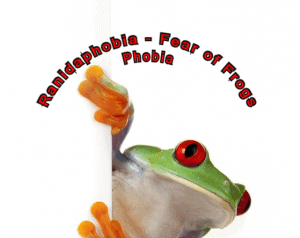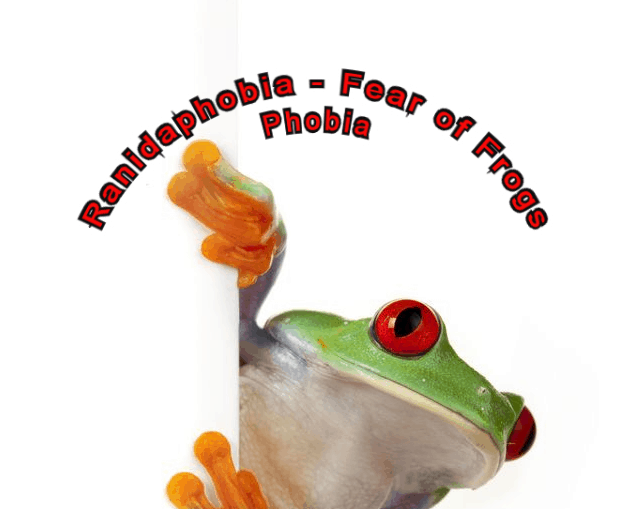Share This Article
Ranidaphobia Is an Excessive Fear of Frogs Phobia
Are you terrified of frogs? Are you afraid of their stillness or sudden jumping?
Do you break into a cold sweat when you see photos of this bug-eyed and slimy creature?
Are you scared of going near long grass or stagnant water because a frog might jump out at you?
Do images of frogs keep flashing through your mind? Do you imagine frogs sitting still then all of a sudden jumping? Is it hard to concentrate on your daily activities because you’re too buried in thoughts about frogs? You may be suffering from ranidaphobia, or a fear of frogs phobia.
Have you ever wondered, Why am I scared of frogs? It seems like such a silly fear. However, you’re not alone in feeling anxious about frogs. Frog anxiety is one of the most common among all animal phobias.
Fortunately, it’s possible to manage the symptoms with a combination of self-help techniques and professional guidance. But first, let’s take a closer look at this phobia.

Everything You Need to Know about Phobia of Frogs
What Is the Fear of Frogs Phobia Called?
Ranidaphobia is the extreme and uncontrollable fear of frogs. Many people don’t like the look of frogs. Their croaking can be creepy, too, especially at night. And if you live near a pond, you’ve most likely experienced being startled by a jumping frog.
But what if a terror of frogs brings your life to a standstill? If that happens, then you may have a phobia. You’re probably thinking, Why do I have a fear of frogs? After you’ve established where this fear came from, it’s possible to get it under control.
Is There a Phobia of Amphibians?
Batrachophobia refers to an extreme fear of amphibians. These are cold-blooded vertebrates like frogs, salamanders, and toads. Batrachophobia is different from ranidaphobia. The second is a specific animal phobia while the first has to do with a larger group of creatures.
What Causes the Fear of Frogs?
The specific cause of frog anxiety is unknown. It varies from one individual to another. Childhood experiences are strongly associated with phobia formation. You could have had had a frightening experience with a frog when you were young. Maybe a frog jumped into your food, and that was it. The events of that dreadful day left an indelible mark in your mind.
You could also have developed frog anxiety from learned behaviors. When younger, did you ever observe older siblings screaming and reacting to the sight of frogs? Perhaps you saw someone play a prank with a live frog and witnessed the hysterics that followed.
In some folktales, frogs catch a bad rap. They are portrayed as cursed beings or as an ingredient for an evil spell. These stories can be a significant contributor to frog anxiety.
Frogs are sometimes associated with dirty places like toilets or swamps. You could develop a phobia of frogs if you have major issues with uncleanliness. Have you ever gone camping as a child and found you did not enjoy the experience? If you’re anxious in nature, there’s a higher chance that you’ll develop frog phobia.
Phobia of Frogs Symptoms
Specific phobia symptoms play out either physically or mentally/emotionally. Physical symptoms manifest immediately upon spotting a frog or coming into contact with one.
In contrast, mental/emtotional symptoms play out even when a frog is not in sight. This is the ultimate frog phobia test.
Physical Symptoms
- Sweating
- Trembling
- Shortness of breath
- Nausea
- Upset stomach
- Increased heartbeat rate
- Dizziness
- Crying and mental breakdown
Mental/Emotional Symptoms
- Overwhelming anxiety when around frogs
- You refuse to even look at pictures of frogs
- Your whole life revolves around avoiding frogs
- You spend most of your time worrying about how you will encounter a frog
- You avoid places where frogs lurk, like the swimming pool or bodies of freshwater
Self-Care Tips to Cope with Ranidaphobia
How do you overcome the fear of frogs? There’s no specific treatment for frog fear, but you can adjust your lifestyle and apply techniques to help you cope. These tips are no guarantee your frog anxiety will vanish. However, if applied consistently, the information should help reduce your anxiety.
Self-care is all about what you can do by yourself. Although not professionally administered, phobia sufferers have discovered they work well.
Expose Yourself to the Object of Fear
Expose yourself to frogs. This is an effective way to get rid of frog anxiety. Start by telling yourself how irrational your fear is. Fear is as big as you make it. Let it register in your mind that the frog you’re exposing yourself to will not bite you. You might end up overcoming frog fear by yourself without seeking any help from a professional.
Allow Yourself to Unlearn and Learn
Read about frogs and what they can do and not do. You might find yourself looking at these creatures differently if you realized their role in the ecosystem. Allow yourself to unlearn the negative perspective you have about frogs by looking at their good side.
Apply Relaxation Techniques
Relaxation techniques include controlled breathing and positive meditation. Counting also helps in relaxing your mind. Do this before leaving your house, especially if you’re going someplace that has frogs.
You can also practice self-affirmations to change your thinking pattern. Tell yourself that you don’t fear frogs and how frogs don’t affect you negatively at all. With time, the self-affirming will start to reflect in real life.
Seeking Frog Phobia Treatment from a Professional
When you consult a professional, expect to go through some form of therapy often involving talk therapy. Medications may be used in extreme cases to relieve physical symptoms associated with the fear. Combined therapies work together to bring your phobia under control.
Exposure Therapy
You will be exposed to frogs slowly in controlled settings. It may start with pictures and illustrations, after which you move to videos. After you have passed this stage, you’re introduced to a real-life frog. While it’s not going to be easy, exposure therapy works to alleviate the phobia. As soon as you can face a frog without fear, the problem is solved.
Cognitive Behavioral Therapy (CBT)
In cognitive behavioral therapy (CBT), a professional will walk you through unmasking your emotions and thoughts. You’ll be required to share what you feel and think about frogs. The therapist’s work is to help you understand your thoughts and emotional patterns and how best to change them. With frogs, your negative perception about them will be changed for a more positive view.
How to Deal with Ranidaphobia
Have you been running away from frogs your entire life? Now, you don’t have to. While taking off seems like a solution, it will make things worse. The more you run away from frogs, the worse your fear will become.
Does facing your fears sound better than running from them? Start by looking at pictures of frogs, then watch a video. Next, try watching a frog from a distance. Move closer to a frog as you begin to feel more comfortable with the situation. When you can confidently stand in a frog’s presence, try and touch it if you feel safe in doing so.
Don’t forget to reach out to the people around you about how you feel about frogs. They may relate and help you cope.
Conclusion
Imagine running away from a harmless creature only to trip and hurt yourself in the process. That’s why it’s a good idea to seek help when frog phobia begins to interfere with your daily life. You need support from someone you trust. Together, you can work to lessen this anxiety.
The next time you spot a frog, apply relaxation techniques like deep breathing. Focus on the fact that the creature is not out there to cause you any harm. Just skip kissing the frog to find your Prince Charming.



